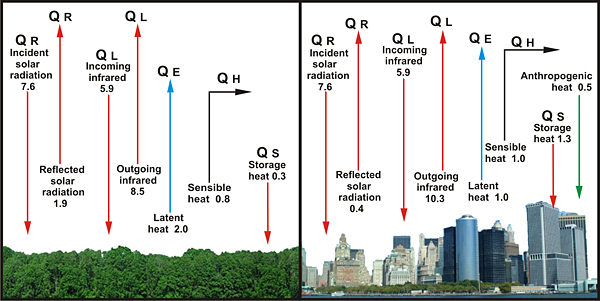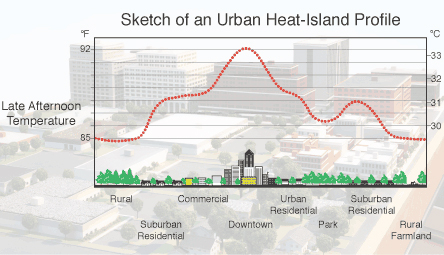 Heat islands are domes of elevated temperatures across the
installation caused by the warmth absorbed by structures and
pavement. It is an increasing problem not only because the increased
air temperatures require more energy for cooling, but because the
higher temperatures aid the formation of ozone and trap other
pollutants. Heat islands are domes of elevated temperatures across the
installation caused by the warmth absorbed by structures and
pavement. It is an increasing problem not only because the increased
air temperatures require more energy for cooling, but because the
higher temperatures aid the formation of ozone and trap other
pollutants.

Figure 1. Radiant heat differences between a rural and urban setting
Heat islands can be diminished by minimizing building footprint,
reducing paving and walkways, and using landscaping and exterior
building design methods, which include cool roofs and vegetated
roofs.
Landscaping: The designer can maximize the use of trees and other
vegetation to shade walkways, parking lots, and other open areas,
being mindful that landscaping should employ indigenous,
drought-tolerant plants. Consider covering or replacing walkways,
parking lots, and other open areas that are paved or made with low
reflectivity (low albedo) materials with high reflectivity (high
albedo) materials or vegetation to reduce heat absorption.

Figure 2. Heat profile sketch
One LEED credit (SS 7.1) can be obtained for this sustainable
strategy through providing shade and/or reflective permeable
materials for at least 50% of the site hardscape (including roads,
sidewalks, courtyards and parking lots). An alternative approach
would be to place a minimum of 50% of parking spaces under cover
(defined as under ground, under deck, under roof, or under a
building). Any roof used to shade or cover parking must have a Solar
Reflective Index (SRI) of at least 29.
Cool Roofs: Dark-colored roofs contribute to the heat island
effect by heating the air around them. On the other hand,
light-colored roofing materials (aka “cool roofs”) reduce energy
loads and extend the life of the roof, particularly in warm
climates. Characteristics of a cool roof include high solar
reflectance, high infrared emittance, and good convective heat
transfer. Cool roofs come in a wide palette of colors, and
may be membranes (e.g., TPO, EPDM, PVC), shingles, tiles, or metal.
Factory applied coatings provide better long-term benefits than
field applied coatings. While metal roofs contain 25-95 percent
recycled content and have low thermal mass, they also have low
emissivity (the ability to shed heat). To obtain a LEED credit (SS
7.2) for this strategy, the designer should utilize roofing
materials with an SRI equal to or greater than the values in the
table below for a minimum of 75% of the roof surface.
|
Roof Type |
Slope |
SRI |
|
Low-Sloped Roof |
≤ 2:12 |
78 |
|
Steep-Sloped Roof |
> 2:12 |
29 |
|

